The term “sustainable city” evokes images of green roofs, energy-efficient buildings, bioswales, bike lanes, urban forests, and other types of green infrastructure. These urban features clearly have value for ecosystem and human health, but they also have great educational potential. Green infrastructure can help urban residents improve their understanding of complex sustainability issues, provide opportunities for residents to interact with urban nature, and potentially encourage citizens to take actions to enhance the environment in cities.
Green infrastructure enhances ecosystem health and climate change resilience, contributes to biodiversity, and benefits human populations.
Green infrastructure can be defined as a network of human-managed and natural ecosystems that together enhance ecosystem health and resilience, contribute to biodiversity, and benefit human populations through the maintenance and enhancement of ecosystem services (Gómez-Baggethun et al., 2013; McPhearson et al., 2016; Novotny, Ahern and Brown, 2010). Green infrastructure projects provide a broad array of human and ecosystem services in areas such as food, energy, security, climate regulation, water management, education, and aesthetics. The field of urban ecology has advanced a conceptual framework that considers the ecology in, of, and for cities (McPhearson et al., 2016). This framing reflects ecological research taking place in cities; a systems approach to study the ecology of cities that considers the complexity and dynamic interactions of social, ecological, economic, and built components; and how the field can be positioned for advancing urban sustainability and resilience (Childers et al., 2015; Grimm et al., 2008; Pickett et al., 2008).
To see more chapters from the book, click here.
Education in green infrastructure refers to the rich opportunities for place-based education in cities. Here we discuss opportunities for using green infrastructure in classroom and after-school activities and deepening student contact with and attachment to their local environment. Education of green infrastructure refers to the vast learning opportunities provided by infrastructure projects in cities, where ecosystem services are entangled with human development and can teach fundamental lessons about systems thinking, sustainability, and resilience.
Environmental education in, of, and for green infrastructure provides significant opportunities for improving human-nature connections in the city.
Finally, education for green infrastructure focuses on the need for increased public education regarding the benefits of green infrastructure, which could increase public support, management, and stewardship of present and future green infrastructure projects. (Education for green infrastructure could also include restoration-based education, see the Ecological Restoration chapter in this volume.) These ideas and the discussion of education in, of, and for green infrastructure below parallel the work of Lucas (1972) who proposed an education in, about, and for the environment. Throughout this exploration of education in, of, and for green infrastructure, we bring these themes to life by sharing case examples used by educators in urbanized areas around the world.
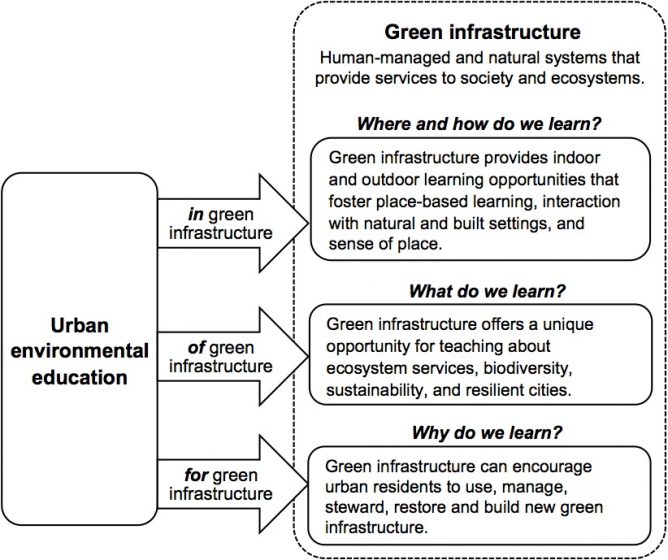
Environmental education in green infrastructure
Environmental education in green infrastructure is concerned with rooting education in place. If green infrastructure in cities can be used for environmental education, then the lessons learned are necessarily about the local environment where learning occurs. In the words of Geertz (1996), “[N]o one lives in the world in general” (p. 259). Place-based education in green infrastructure can make abstract ecological principles concrete.
Demonstration projects can illuminate the potential for environmental education in green infrastructure. For example, the Center for Sustainable Building Research at the University of Minnesota in the U.S. initiated a demonstration project entitled “Art, Story, and Infrastructure: A Model for Experiential Interconnection in Environmental Education.” This project takes kindergarten students on a tour of the urban water cycle using water infrastructure from the Minnesota landscape, from treatment facilities to the school building sink, all the while incorporating place-based environmental education and participatory art. Another example is the Urban Ecology Center at Riverside Park in Milwaukee Wisconsin (Figure 2). This center showcases a green building, solar power station, public art, urban wasteland being transformed into a park, riparian habitats, classrooms, and a climbing wall, all of which are intended to improve visitors’ environmental experiences and knowledge. Educational efforts such as these are rich in their ability to string together disciplines like civil engineering, landscape architecture, and building design to trace both ecological and human processes—all grounded in the learners’ lived environment.
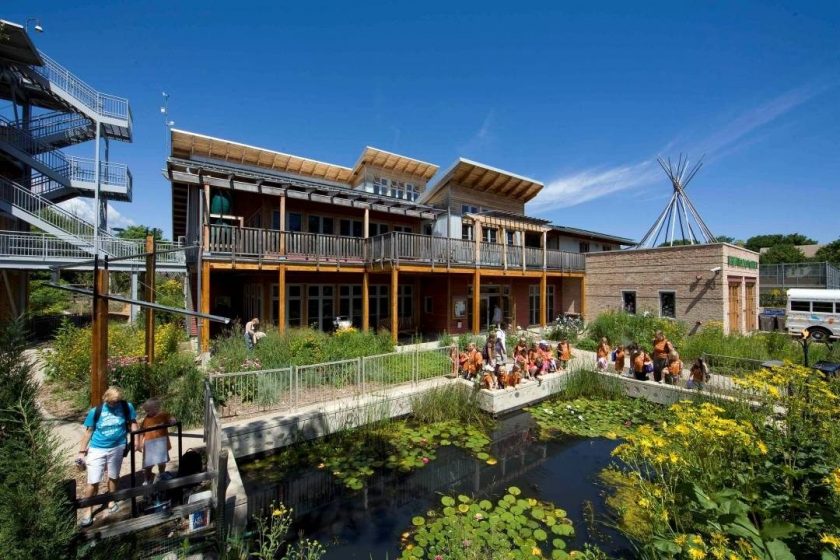
Despite the potential to use place-conscious education and systems thinking to advance sustainability education, current public educational models are challenged to use these approaches. Such strategies may require additional financial resources and time from school districts and teachers. Moreover, some green infrastructure projects lack access and educational interpretation, making them difficult destinations for classroom field trips. Further, the place-based nature of education in green infrastructure may not align with more abstract, place-neutral methods of educational assessment that emphasize measurement and accountability. Examples around the world illustrate the potential of environmental education in green infrastructure, though neighborhoods and cities may need to invest additional resources to unleash this potential.
Environmental education of green infrastructure
Environmental education in green infrastructure entails formal and informal place-based learning in built and natural green infrastructure settings.
Urban environmental education provides opportunities to teach the benefits of green infrastructure and therefore improve urban residents’ understanding of the impact that green infrastructure has on their own health and well-being. This approach includes lessons about planning and designing multifunctional and inclusive urban green infrastructure. Teaching about green infrastructure can borrow ideas from urban ecology to increase public understanding of high-performing social, ecological, and biophilic landscapes (Beatley, 2011; Novotny, Ahern and Brown, 2010). In particular, the concept of ecosystem services, a widely used term in urban ecology (Elmqvist et al., 2013), can be used to frame the benefits of green infrastructure and ecosystems for human health and well-being. For example, in San Francisco, the California Academy of Sciences provides tours of its Leadership in Energy and Environmental Design-certified (LEED) green building to teach visitors about using green infrastructure to reduce waste, save energy, reuse materials, provide healthy indoor environments, create rooftop habitats for birds and insects, and other ecosystem services (Figure 3).
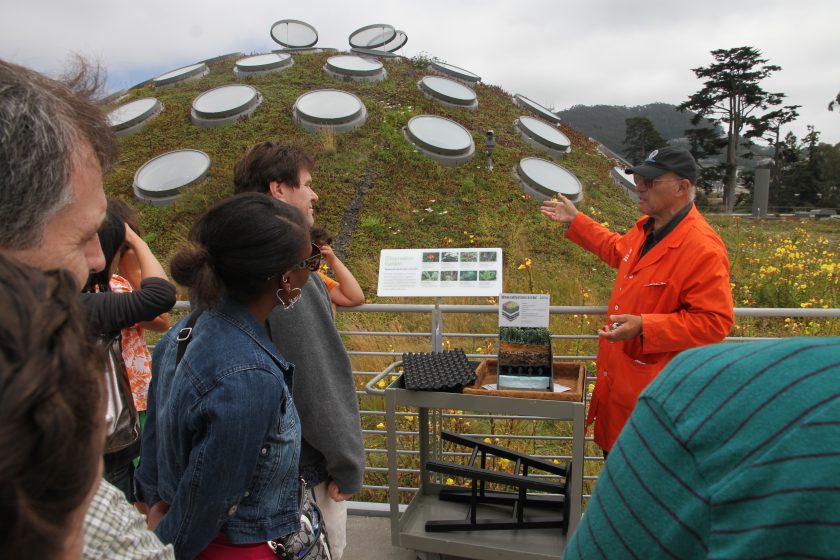
In general, ecosystem services refer to those ecosystem functions of green infrastructure that are used, enjoyed, or consumed by humans. Ecosystem services can be categorized into four types: provisioning services (e.g., drinking water, raw materials, and medicinal plants); regulating services (e.g., pollination, water purification, carbon sequestration, flood control, climate regulation); habitat and supporting services (e.g., nutrient cycling, soil formation, photosynthesis, habitat for species); and cultural services (e.g., recreational, educational, and spiritual experiences) (Gómez-Baggethun et al., 2013; Millennium Ecosystem Assessment, 2005; TEEB, 2011). Urban residents, whether they know it or not, rely on ecosystem services produced by green infrastructure both within and outside the city. Urban green infrastructure is especially important in providing services with direct impact on human health and security such as air purification, noise reduction, urban cooling, and stormwater runoff mitigation, but also provides places for social cohesion and connection, recreation, and development of sense of place. Further, green infrastructure is being increasingly used as a nature-based solution for climate change adaptation and mitigation in cities (McPhearson et al., 2016). For example, cities are investing in green infrastructure as a specific management tool for combining engineered and ecological systems (e.g., bioswales) in place of engineered non-ecological systems (e.g., concrete sewer drains) to provide ecosystem services such as cooling, stormwater management, urban heat island reduction, carbon storage, flood protection, and recreation (Novotny, Ahern and Brown, 2010).
Environmental education of green infrastructure is about the ways in which cities provide opportunities for complex and interdisciplinary sustainability lessons. Green infrastructure offers lessons in science, mathematics, art, design, history, social studies, and beyond. From stormwater pathways to pocket parks with bird habitat to plazas with permeable surfaces, green infrastructure in cities provides endless venues for lessons about how human settlements interact with ecosystems. In urban environmental education, green infrastructure gives visibility to processes such as water flowing through cities, sunlight converted to heat and electricity, food being grown, species migration using greenway trails, and urban forests that support biodiversity and recreation.
Environmental education of green infrastructure offers a framework for teaching about the benefits of urban green infrastructure, such as ecosystem services.
Cities are complex and best studied as an entanglement of systems that are social, cultural, technical, and ecological in nature (e.g., Grimm et al., 2008; McPhearson et al., 2016; Pickett et al., 2008). By focusing on the multiple functions of green infrastructure, urban environmental education teaches about systems thinking. For example, urban community gardens provide food, absorb excess stormwater, mitigate microclimate fluctuations, support urban biodiversity, and provide aesthetic benefits. These gardens become places for recreation, reflection, social bonding, and cohesion. Similarly, green roofs and vegetated areas, including trees, can increase rainwater infiltration and reduce peak flood discharge and associated water pollution while also delivering mental and physical health benefits such as providing spaces for recreation, relaxation, and reducing stress. These kinds of green infrastructure projects are critical for building community resilience, and simultaneously offer rich contexts for urban environmental education.
Environmental education for green infrastructure
Environmental education can amplify public support for green infrastructure. Urban environmental educators can play a critical role in fostering support for current and future green infrastructure projects, helping cities push toward a community-based form of urban land management that has been described as urban ecological or civic ecology stewardship (Krasny and Tidball, 2015; Svendsen and Campbell, 2008). Environmental education can help to promote, create, and maintain green infrastructure in multiple ways.
First, educators can involve adults and children in the planning and maintenance of green infrastructure. Such projects may require deep and sustained partnerships between local governments, grassroots, nonprofits, businesses and schools. For example, in the Bronx, New York City, community-based organizations such as the Bronx River Alliance, Youth Ministries for Peace and Justice, and The POINT Community Development Corporation involved high school students and other urban residents in designing a concept plan for greenways along urban rivers and streets. As another example, the 1.2 hectare Grands-Moulins – Abbé-Pierre garden in Paris offers an inspiring instance of how residents actively manage green spaces and rediscover nature in the city. These examples show that diverse members of urban communities can play a role in decision-making about green infrastructure development.
Environmental education for green infrastructure provides opportunities for promoting urban environmental stewardship by meaningfully engaging residents.
Second, urban environmental education can involve people in using green infrastructure. With bike lanes, gardens ready for growing vegetables, and green buildings open for tours, cities are providing green infrastructure projects that become dynamic examples of sustainability woven into the daily life of citizens. In this way, green infrastructure acts as a stage for informal environmental education as people spontaneously engage “hands-on” with green infrastructure projects. For example, many community-based education/restoration organizations in the U.S. offer free canoeing in restored urban waterways for residents to rediscover local recreational opportunities, potentially raising public support for urban open space.
Third, education related to green infrastructure may inspire interest and future action to expand green infrastructure in cities. Berlin offers an example of how citizens knowledgeable about the benefits of open and multi-functional spaces engaged in supporting the revitalization of an urban green space. In the 1980s, local residents formed a nonprofit organization to protect an 18-hectare railyard. The former railyard had been abandoned for five decades during Berlin’s separation of East and West, a circumstance that allowed the landscape to regenerate while untouched by development. Despite the area’s proximity to a densely populated neighborhood, civic activists and professional planners influenced policy makers to protect it. Their efforts, along with ecological research, helped transform the area into the Natur-Park Südgelände, opened in 2000 (Kowarik and Langer, 2005) (Figure 4). The park offers a model for green infrastructure that fosters a strong sense of place for residents by nurturing cultural values related to art, education and sport. In this way, it also provides opportunities for education in and of green infrastructure.
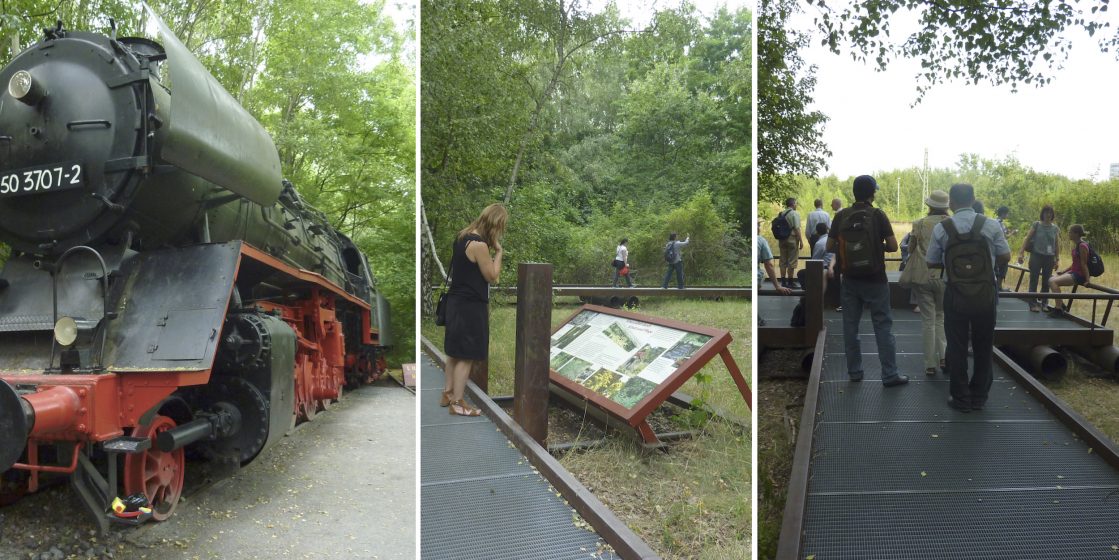
Conclusion
Urban environmental educators working in, of, and for green infrastructure offer a unique voice as cities design, build, and promote ecologically- and socially-conscious infrastructure. In particular, we suggest that environmental education in green infrastructure can offer nature-based opportunities for place-based environmental education, help to build sense of place, and use spaces that otherwise may not be perceived as educational (e.g., waste management facilities, mechanical rooms of green buildings, and bioswales). Advancing environmental education of green infrastructure can help to showcase the social and ecological benefits of urban green infrastructure to residents’ everyday lives, thus increasing awareness of the value of urban nature. Finally, we suggest that environmental education can be employed for encouraging hands-on stewardship or restoration of green infrastructure, as well as programs that encourage cities to build new and better manage existing green infrastructure.
Laura Cole, Timon McPhearson, Cecilia P. Herzog, and Alex Russ
Columbia, MO; New York City; Rio de Janeiro; and Ithaca
* * * * *
This essay will appear as a chapter in Urban Environmental Education Review, edited by Alex Russ and Marianne Krasny, to be published by Cornell University Press in 2017. To see more pre-release chapters from the book, click here.
References
Beatley, T. (2011). Biophilic cities: Integrating nature into urban design and planning: Washington, DC: Island Press.
Childers, D.L., Cadenasso, M.L., Grove, J.M., Marshall, V., McGrath, B. and Pickett, S.T. (2015). An ecology for cities: A transformational nexus of design and ecology to advance climate change resilience and urban sustainability. Sustainability, 7(4), 3774-3791.
Elmqvist, T., Fragkias, M., Goodness, J., Güneralp, B., et al. (Eds.). (2013). Urbanization, biodiversity and ecosystem services: Challenges and opportunities: A global assessment. Dordrecht: Springer.
Geertz, C. (1996). Afterword. In Feld, S. and Basso, K. (Ed.), Senses of place (pp. 259-262). Sante Fe, New Mexico: School of American Research Press.
Gómez-Baggethun, E., Gren, Å., Barton, D.N., Langemeyer, J., et al. (2013). Urban ecosystem services. In Elmqvist, T., Fragkias, M., Goodness, J., Güneralp, B., et al. (Eds.). (2013). Urbanization, biodiversity and ecosystem services: Challenges and opportunities: A global assessment (pp. 175-251). Dordrecht: Springer.
Grimm, N.B., Faeth, S.H., Golubiewski, N.E., Redman, C.L., et al. (2008). Global change and the ecology of cities. Science, 319(5864), 756-760.
Kowarik, I. and Langer, A. (2005). Natur-Park Südgelände: Linking conservation and recreation in an Abandoned Railyard in Berlin. In: Kowarik I, Körner S (eds) Wild Urban Woodlands. Springer-Verlag Berlin Heidelberg 2005, pp 287–299
Krasny, M.E. and Tidball, K.G. (2015). Civic ecology: Adaptation and transformation from the ground up. MIT Press.
Lucas, A.M. (1972). Environment and environmental education: Conceptual issues and curriculum implications. Columbus, Ohio: Ohio State University.
McPhearson, T., Pickett, S.T.A., Grimm, N., Niemelä, J., et al. (2016). Advancing urban ecology toward a science of cities. BioScience, 66(3), 198-212.
Millennium Ecosystem Assessment. (2005). Ecosystems and human well-being: Synthesis. Washington, DC: Island Press.
Novotny, V., Ahern, J. and Brown, P. (2010). Water centric sustainable communities: Planning, retrofitting and building the next urban environment: Hoboken, New Jersey: John Wiley & Sons.
Pickett, S.T., Cadenasso, M., Grove, J., Nilon, C., et al. (2008). Urban ecological systems: Linking terrestrial ecological, physical, and socioeconomic components of metropolitan areas. In: Editors Marzluff, J., Shulenberger, E., Endlicher, W., Alberti, et al. (Eds.). Urban ecology: An international perspective on the on the interaction between humans and nature (pp. 99-122): New York: Springer.
Svendsen, E. and Campbell, L. K. (2008). Urban ecological stewardship: understanding the structure, function and network of community-based urban land management. Cities and the Environment (CATE), 1(1), 4.
TEEB – The Economics of Ecosystems and Biodiversity. (2011). TEEB Manual for Cities: Ecosystem Services in Urban Management.
about the writer
Timon McPhearson
Dr. Timon McPhearson works with designers, planners, and local government to foster sustainable, resilient and just cities. He is Associate Professor of Urban Ecology and Director of the Urban Systems Lab at The New School and Research Fellow at the Cary Institute of Ecosystem Studies and Stockholm Resilience Centre.
about the writer
Cecilia Herzog
Cecilia Polacow Herzog is an urban landscape planner, retired professor at the Pontifical Catholic University of Rio de Janeiro. She is an activist, being one of the pioneers to advocate to apply science into real urban planning, projects, and interventions to increase biodiversity and ecosystem services in Brazilian cities.
about the writer
Alex Russ
Alex Kudryavtsev (pen name: Alex Russ) is an online course instructor for EECapacity, an EPA-funded environment educator training project led by Cornell University and NAAEE.


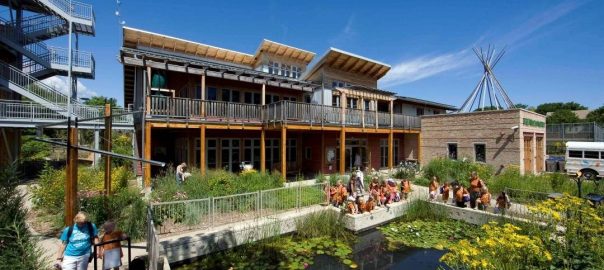
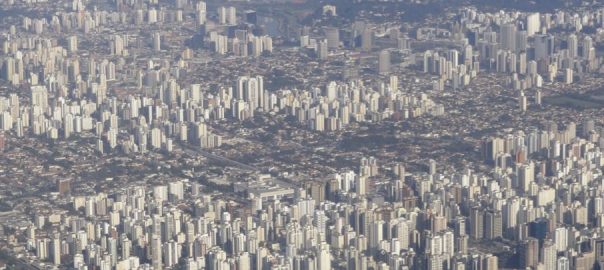

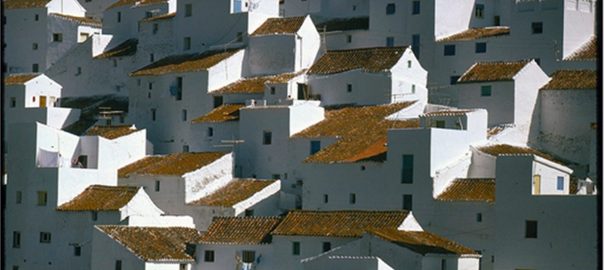
Leave a Reply